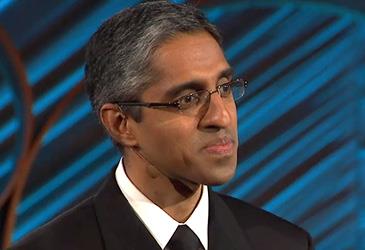Happiness and small acts of gratitude are helping communities create innovative public health solutions, according to U.S. Surgeon General Vivek Murthy, MD. Here’s one simple yet profound way he says happiness benefits communal health.
Dr. Murthy said he has traveled to various communities throughout the country and has witnessed the unexpected benefits happiness can have on public health. 
“Happiness affects us on a biological level. Happy people have lower levels of cortisol, a key stress hormone,” he said during a presentation at TEDMED 2015. Happy people “have more favorable heart rates and blood pressure levels. They have strong immune systems … and lower levels of inflammatory markers like C-reactive protein that is linked to coronary heart disease. It turns out that even when you control for smoking, physical activity and other health behaviors, happy people live longer. There’s something about happiness that seems to be protective.”
He noted that this “happiness” isn’t predicated on the feelings people experience from “indulgence or hedonism,” but rather a sense of “long-term emotional well-being that comes from fulfillment, purpose, connectedness and love.”
“Now you may ask yourself, ‘Does happiness really lead to better health? Isn’t it the other way around—doesn’t happiness result from good health and favorable circumstance?’” Dr. Murthy said, noting that people often think their happiness hinges upon contingencies, such as losing 15 more pounds, getting a better job or earning more money.
However, “the truth is that while circumstances can and do impact our short-term happiness, our long-term happiness is far more driven by how we process life events than by the events themselves,” he said.
Contrary to popular belief that happiness is innate, Dr. Murthy said research shows that people can actually “create happiness” using gratitude exercises, meditation and social connectedness.
A lesson on creating happiness: Visitacion Valley Middle School
“Perhaps one of the most powerful examples of cultivating happiness comes from Visitacion Valley Middle School in San Francisco,” Dr. Murthy said. “Some years ago, Visitacion was struggling.”
Dr. Murthy visited the school the day before giving his presentation at TEDMED 2015, which is where he learned that eight years ago, Visitacion school suffered from low test scores, high suspension rates and “so much violence that the school had to hire a full-time grief counselor.”
Teachers tried afterschool programs, peer counseling and sports programs to help mitigate students’ anger and improve attendance rates, but none of them proved effective. Then the school decided to “take a leap of faith” and try a non-traditional approach to reducing stress and improving mental health for students, Dr. Murthy said.
School staff “created two 15-minute ‘quiet time’ meditation sessions [for] each school day. They taught the teachers and students how to meditate. They taught the administrators how to meditate as well. And within a year, something incredible happened: Suspension rates dropped by 45 percent, teacher absenteeism dropped by 30 percent, and test scores and grade point averages rose markedly,” Dr. Murthy said.
Students also reported that they were less anxious, slept better and “their self-reported happiness scores went from one of the lowest scores in San Francisco to the highest in the district …. These are remarkable stories,” Dr. Murthy said.
Visitacion’s meditation model is now being replicated as a tool for happiness and improving student health in various schools across the country.
“What is so striking about these tools for increasing happiness—meditation, gratitude, social connection, exercise—is that they are so simple and accessible,” Dr. Murthy said. “We have become accustomed to thinking that complex problems require complex solutions, but that’s not always the case. Sometimes simple solutions can enable us to take on some of our most intractable problems. That’s what happiness can do when it comes to health."




